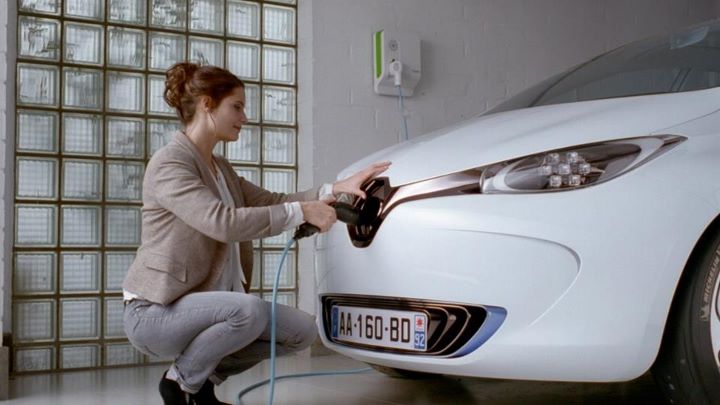Renault Zoe: preview
March 1st, 2012 Text and images © ecodrive 2012 unless otherwise stated. No reproduction without express permission.
The 'concept' version of Renault Zoe has been teasing TV audiences since December 2011 as the poster child for Renault's new EV ad campaign, in which they illustrate the plethora of ways that we use electricity everyday by showing electrical appliances running on combustion engines, encouraging us to adopt electric power for transport too.
Following the launch of Kangoo ZE in January and
Fluence ZE & the scooter-chasing scamp Twizy in the
Spring, Zoe will not be on sale until Autumn 2012, but
it will be worth the wait. We state categorically
here and now that Renault Zoe is the most important
new-generation EV to date. You can quote us on
it. A bold statement? Perhaps. Let's
put our reasoning (and Renault's prodigal EV child)
under the microscope…
The production version of Zoe has just been unveiled at the Geneva Motor Show: visually, it's not that remarkable. Sorry Renault designers - it isn't. It's a 'B segment' 5-door hatchback, the size of a Ford Fiesta or VW Polo. Quite striking headlights are slashed into the rounded nose. Angular swage lines flow from the front and rear light clusters and melt away into the doors. It uses the now commonplace trick of disguising the rear door handles, fitting them flush into the black window frame, to make it appear to be a more desirable and well-proportioned 3-door model. Despite the steeply raked windscreen, it has a fairly conventional profile with a discernible bonnet which might suggest that it is a 'conversion' from a combustion model (which it isn't by the way!)
Don't judge this book by its cover
But that's kind of the point, it looks... conventional: contemporary but conventional. The kind of inoffensive shape that anyone would be happy to drive as basic transportation, more so than the space-efficient, egg-shaped Mitsubishi i-MiEV (and Peugeot iOn / Citroen C-Zero versions) which are its closest size rival and the comparatively portly, over-sized and stylised Nissan LEAF, both of which tend to polarize opinions.
 |
|
|
So a market-leading range is the big fanfare?
Well, the other and even more significant design point
is that the car has a built-in fast charger which can
make a near-full recharge in 30 minutes (from
flat) Yes, you still need a special three-phase
charging station to do this, but it is a far simpler and
cheaper affair than the bulky and hitherto expensive
'off-board' quick chargers that the Japanese origin
vehicles use. In Japan and North America, three-phase
power is so rare that it is impractical to use it
straight into a vehicle, so they have no choice but to
use the 2 charge port design: one for normal mains and
one for quick-charge that goes straight to the battery.
With the battery mounted under the floor and all of the electronics contained under the bonnet, Zoe has a normal-sized boot for a car of its size although, from the pictures we've seen so far, we have a slight reservation that it may lack rear legroom (like Nissan LEAF) due to a higher floorpan than normal. We'll report back on this when we've tried it out!
As well as the preconditioning feature (as becoming standard on new EV models) allowing pre-heating or pre-cooling of the interior from the mains before setting out, Zoe features a new 'heat pump' heating/cooling system requiring only one-third of the energy to heat, or one-half the energy to cool, the interior - preserving more of the already impressive range.
Charging into the future
Conventional EV designs have used two separate lots of electronics: one to feed power to the motor during driving in response to your right foot and one to charge the batteries from the mains when you're parked - and you haul it around doing nothing whilst you're driving. Zoe combines the electronics into one unit that does double duty: during driving it takes the battery energy and turns it into three-phase power to feed the motor at up to 65kW; during charging the same unit works in reverse to take three-phase mains power and replenish the battery at up to 43kW depending on the capability of the supply.
 |
|
|
The cutesy factor with Renault Zoe (as seen in the TV advert) is that the charging cable plugs into the single, universal inlet which hides behind the large Renault diamond in the front grille, although on the production car it is a simple hinged affair rather than the gliding motion shown in the advert. You use this same single inlet with a 'wallbox' at home for a 4-9 hour charge (overnight) or at a normal public charger (usually with a portable cable) to gain about 25 miles' driving per hour of charging or roll up to the special quick charge sites for a half-charge in 15 minutes, or nearly full in about 30 minutes. In fact, it is a continuum rather than discreet steps, so an intermediate charger can be a cost-effective and time-effective solution.
And the perfectly proportioned Zoe has a chance (unlike LEAF) of fitting into a normal domestic British garage and the driver still being able to reach the front of the car to plug it in!
Verdict
Goldilocks size; market-leading 80-110 mile range ; built-in fast three-phase charging; affordable and upgradeable through battery rental. Yes, for so many reasons the contemporary hatchback that we will come to know as Zoe should set the EV market alight. Other manufacturers take note: you WILL be playing catch-up.
Renault Zoe will cost from £13,650 (including the Plug-In Car Grant) On The Road + around £70 (inc VAT) per month for battery rental (based on a 36 month contract at 6,000 miles per year.)
» Express your interest in Renault Zoe now